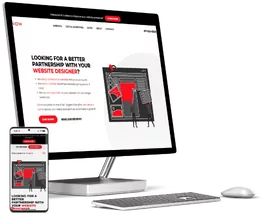Healthcare web designs need to be modern, simple, and easy to navigate in order to benefit a range of patients. When patients visit their healthcare provider’s website, they expect to find a site that’s easy to use. But what qualifies a healthcare website as easy to use?
As a web design company, we’ve created numerous healthcare websites that keep patients in mind. At Compete Now, our team of web designers and marketers have contributed knowledgeable experience and creativity to over 200 websites. For a team that creates thoughtful and engaging healthcare web designs, call us today to get started! In the meantime, learn about our web design dos and don’ts when creating a healthcare website.
Do: Use Inclusive Accessibility Features
Patients of all backgrounds and with varying needs should be granted an easy web experience. To do this, we recommend including an accessibility widget and a language switcher widget. With an accessibility widget, users have the ability to change the size of the website’s font, contrast, spacing, and more for a comfortable user experience. A language switcher widget can automatically translate the text on your website for users who don’t speak English. When we designed the Charles River Center’s website, we included both of these features, as seen below.
The accessibility widget appears in the bottom left corner and expands into a full menu of options when clicking on it. The language switcher is also easy to find, remaining in the top right corner as users navigate the website.
Don’t: Allow Information to Get Outdated
A common mistake website owners make is allowing information to get outdated. It’s important that you update important information, like events, contact information, and privacy policies, consistently so users aren’t fed incorrect information. We recommend regularly reviewing and updating content to reflect current practices once a month so you don’t forget!

Looking to Redesign Your Website? Contact Us for a Quote
Get Started
Do: Provide Clear Contact Information
Provide clear and updated contact information that’s easy to find the moment users visit your homepage. You can do this by including a phone number and address in the header. When we created MEDA Inc’s website, we included their phone number and address in the header, as seen below, for convenience.
If you’d rather not include it in the header, we recommend implementing a call to action button for your contact page so users can quickly navigate to a phone number or email.
Don’t: Forget About Mobile Users
The key to a user-friendly healthcare web design is ensuring it works for all users visiting the website. So don’t forget about mobile users! As of this year, almost 50% of web traffic in the U.S. comes from mobile devices. Meaning, a large percentage of your patients will be accessing your website from their phones. Ensure that your website is mobile-responsive by including mobile-friendly features like drop-down menus. We recommend testing your website on Google Search Console to find out if it’s mobile-friendly before getting started.
Do: Include Educational Content
Include educational content pertaining to common health topics and preventive care to keep patients up to date on important issues. For example, it’s common for healthcare centers to remind patients to get their flu shots during the fall. Featuring educational content like this will position your center as a valuable resource.
Don’t: Have Inconsistent Branding
Don’t have inconsistent branding across your website because it will come across as unprofessional and will most likely confuse patients. By maintaining a cohesive design and voice across your healthcare web design, you strengthen your reliability as a center. With the design we developed for BHCHP’s website, we ensured the font, voice, and colors remained consistent throughout the website, as seen below.
As you click through the web pages, you’ll notice how the blue they use in their logo is used on every page to emphasize their branding.
Do: Implement Search Engine Optimization (SEO)
Do implement search engine optimization (SEO) on your website! Search engine optimization can boost your visibility on Google. By optimizing your content with relevant keywords and proper heading structure, you increase your chances of popping up in people’s search results. You also improve your ability to reach more local patients with healthcare center SEO. Call us for professional SEO services that can benefit your business’s online traffic!
Don’t: Overcomplicate Language
Don’t use complicated medical jargon that will confuse patients. It seems like an obvious recommendation, but by simplifying your language, you’re minimizing any chance of confusing patients. While we were creating the Codman Square Health Center’s healthcare web design, we continuously populated the website with simple and engaging language.
As you scroll through their pages, especially their health resources, you’ll find their content easy to read because of the language.
Do: Add a Language Switcher
Adding a language switcher to your website will make your site accessible to users of all backgrounds and languages. Adding this element is as simple as adding a plugin to your site. We recommend using a plugin like GTranslate to allow non-English-speaking patients to switch to their spoken language. This plugin offers several different display options for free and has a premium version that translates URLs as well.
Call Compete Now to Revamp Your Healthcare Web Design
We’ve worked with a variety of healthcare clients to build websites that act as a valuable resource for their patients. If you’re unsure of how to start your healthcare web design, don’t hesitate to reach out to us for help!

